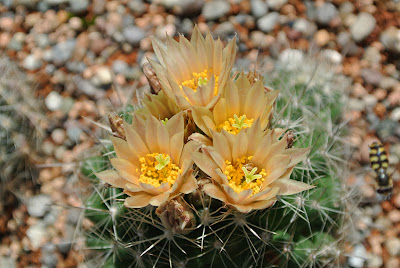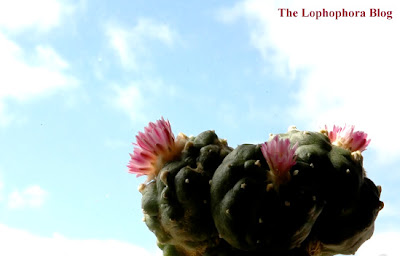
Escobaria vivipara with a light snow cover
I’m fascinated by the ability of certain cacti species to survive even quite extreme freezing conditions. A fascination that is probably rooted in my childhood belief that all cacti were heat craving desert dwellers that would succumb to subfreezing temperatures - great was my surprise the first time I saw pictures of a cactus covered in snow.

Echinocereus triglochidiatus var. mojavensis sprinkled with snow
I live in a condominium and the only possibility for pursuing my interest in growing frost tolerant cacti outdoors - apart from the bed of winter-hardy cacti at my summerhouse - is to grow cacti in flower boxes on the balcony.
For several years I have successfully grown Echinocereus triglochidiatus (claret cup hedgehog cactus) outdoors (year-round) at my summerhouse in the northwestern part of Denmark - inspired by this I acquired a few E. triglochidiatus var. mojavensis (DJF1273; North of Inyo County, California) plants for my flower boxes a couple of years ago and they are also doing great.

Escobaria missouriensis in the snow
The well-being of the Escobaria species are of greater concern to me. The Botanical Garden of Copenhagen attempted growing Escobaria in their outdoor cactus bed but they all perished. My plants still seem to be weathering it out here in Copenhagen but I’m concerned that the continuous frost-thaw cycles will expose the plants to killing moisture.
Denmark has been frost-bound for several weeks now with the plants seeing temperatures as low as -10 C (14 F) (this is nothing for Escobaria vivipara which is known to have survived extreme temperatures as low as -35 degrees C) but the frost now loosens its grip again and it has started to rain, soaking the flower boxes that are still frozen solid. I hope that the light shelter provided by the balcony on the floor above will keep the plants from getting too wet - if not, I reckon the rot will soon show in the coming period of relatively warm and humid weather.
The beehive cactus species I’m growing in flower boxes on the balcony are Escobaria vivipara (Alberta, Canada) and Escobaria missouriensis (Mesa County, Colorado; SB204)

Flower box with Escobaria and Echinocereus cacti in the snow
This coming season I plan to grow peyote cactus in outdoor window boxes as well - but I don’t expect peyote to cope well with the Danish winter so the plants will need to be wintered in the attic.
Below are a few pictures of the balcony grown Escobaria plants during summer - what a happy flowering bunch :-)

Flowering Escobaria vivipara (Alberta, Canada)

Flowering Escobaria missouriensis (Mesa County, Colorado; SB204)
In relation to the two above images, the previous post featured a high-speed video showing the flower fly hovering above the Escobaria vivipara cactus.
Sunday, January 27, 2013
Snow covered cacti on the balcony
Monday, January 21, 2013
Hoverfly visiting a flowering Escobaria vivipara (Alberta, Canada) cactus
While preparing a post on the cold-hardy cacti I'm growing in flower boxes on my balcony I stumbled upon this high-speed video I shot last summer. The video shows a hoverfly visiting a flowering Escobaria vivipara (Alberta, Canada).
Hoverflies, sometimes called flower flies or syrphid flies, make up the insect family Syrphidae - a group of superbly beneficial insects, the adults being pollinators and the hoverfly larvae being predators of aphids and other damaging insect pests and their larvae. The coloring and movements of most species mimic bees or wasps giving them some protection against being eaten by birds.
I’m by no means an entomologist and to my untrained eye the flower fly in the video looks like a Scaeva selenitica (a common European species of hoverfly) with its three pairs of yellow comma markings on the abdomen. If you are an expert on insects and recognize the fly I would be happy to know the exact species.
If the above video doesn’t embed properly you can open it in a separate window by clicking the image below.

Hoverfly (Scaeva selenitica?) visiting flowering Escobaria vivipara (Alberta, Canada)
The high-speed video was filmed at the end of June 2012 using a Nikon 1 J1 camera.
Thursday, January 17, 2013
TimeScapes: Death is the Road to Awe
I'm fascinated by time-lapse videos - especially the ones that include cactus related footage. Tom Lowe is a great inspiration when it comes to time-lapse filming and has recently released the movie TimeScapes that features stunning slow-motion and time-lapse cinematography of the landscapes, people, and wildlife of the American South West.
Tom has made several clips available on Vimeo including the one below featuring giant saguaro cacti (Carnegiea gigantea) reaching for the soaring night sky.
If the video doesn't embed properly you can view it in a separate window by clicking the picture below.

Saguaro cactus (Carnegiea gigantea) lit by a military drop flare
A particularly epic sequence is filmed on the East side of the US Air Force's Goldwater bombing range near Ajo, Arizona, and shows a saguaro cactus (Carnegiea gigantea) towering in a desert landscape painted by the lights from military flares dropped from planes.
The above picture is courtesy of Tom Lowe @ Timescapes' photostream (where you can find a lot more beautiful photos).
Tuesday, January 08, 2013
Time-lapse video of a flowering Ariocarpus kotschoubeyanus var. macdowellii cactus
Flowering Ariocarpus kotschoubeyanus var. macdowellii (SB 100; El Pilar, Coahuila) - please note that the time-lapse video is generated with a fairly high frame rate meaning that you can slow down the video to 0.5x its speed (or even 0.25x) with good results - the playback speed is controlled via the settings for the YouTube video.
As mentioned in the previous post I broke the shutter of my old faithful Nikon D70 SLR camera while capturing photos for a time-lapse video of a flowering peyote. A time-lapse video of just a few seconds duration requires hundreds of photos and thus imposes a considerable wear on SLR cameras with mechanical shutters. Consequently I have avoided using my new SLR for time-lapse shooting and instead experimented with alternative solutions. One of these being iTimeLapse Pro for the iPhone - an app that allows you to control basic settings like the capture interval, when to stop and start capturing images, and the capture resolution.
The app was used for shooting the images for this video and as such functions just fine, but I still need to work on enhancing the steadiness of the phone (it slid slightly on its stand during the capture sequence), and on tuning the focus (which is slightly behind the center of the flower, making the flower itself look blurry). Also the images are taken in natural light that changes continuously giving the video a flickering appearance - on the other hand the change in light is also responsible for the flower closing again, adding to the video.
I also shot photo sets for a flowering peyote ( Lophophora williamsii var. echinata) and a Gymnocalycium calochlorum and will generate and upload time-lapse videos for these as time permits.
For the technically inclined it must be mentioned that the video was generated using FFmpeg, a free set of tools to record, convert, stream and play multimedia content. FFmpeg can be downloaded here. The photos used in the video were shot one every 15 seconds and is played back at a rate of 25 images per second. The time-lapse video comprises 1001 still images.
If the video doesn't embed properly you can view it in a separate window by clicking the picture below.

Wednesday, January 02, 2013
Peyote in the sky...
Time flies... as do the clouds in the above video. 8 years ago today this blog was started off with a test post featuring a picture of a field of Cylindropuntia bigelovii photographed in Joshua Tree National Park (maybe I should do another C. bigelovii post as I have lots of beautiful pictures from that and later visits to the park ;-)
As a curiosity it can be mentioned that I broke the shutter of my old Nikon D70 doing the above time-lapse video a couple of years ago. The video is rather short (as the shooting ended prematurely) and doesn't show the flower unfold, but I thought it would fit nicely with this post, illustrating the passing of precious time.
If the video doesn't embed properly you can view it in a separate window by clicking the picture below.

Peyote in the sky...
All Time Most Popular Posts
-
Lophophora williamsii (peyote) populations have diminished in large areas of South Texas where peyoteros harvest the cactus for ceremonial ...
-
On various occasions I've been asked what growing media I'm using for my cactus plants. I don't have a set soil mix recipe as su...
-
Below is a list of retailers/nurseries selling cactus seed and plants. I've only listed vendors I've done business with. If you ar...
-
Most cacti are easily grown from seed - and with a little patience and care they can be grown into beautiful plants. Lophophora williamsi...
-
In last month’s post on the troubled Texan peyoteros I referred to Anderson’s article on the peyote situation in Texas. Given the importanc...
-
Yet another slightly off topic and probably not entirely politically correct post, but I couldn’t help noticing the similarity of my monstr...
-
Flowering stand of San Pedro cacti (Trichocereus pachanoi) To me the main draw of the San Pedro cactus ( Trichocereus pachanoi (syn. Ech...
-
In the June 2008 issue of the Cactus & Co magazine Jaroslav Šnicer, Jaroslav Bohata, and Vojtěch Myšák described a new Lophophora spec...
-
There seems to be an increased focus on the alarming Texas peyote situation. A couple of weeks ago the Houston Press published a mournful, i...
-
I spent two weeks working in Delhi, India during January. I had one weekend off and had planned to spend it in Delhi at my own leisure, but ...


















